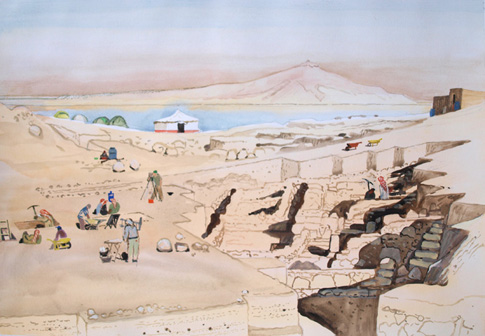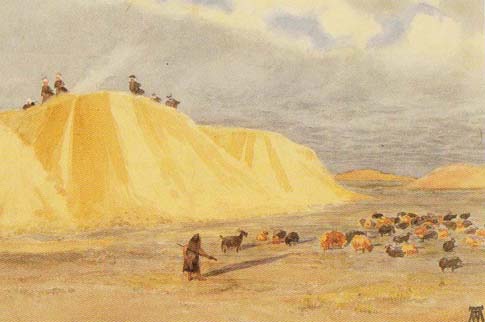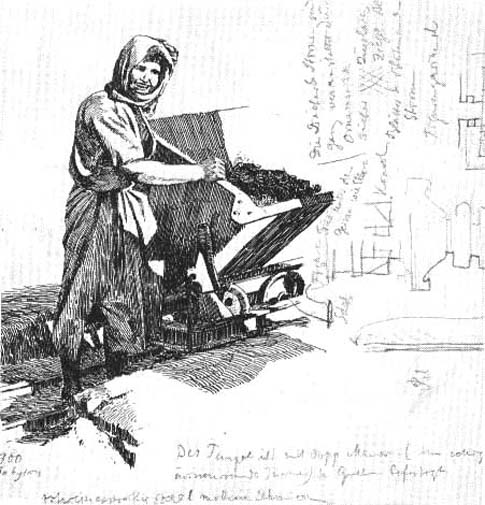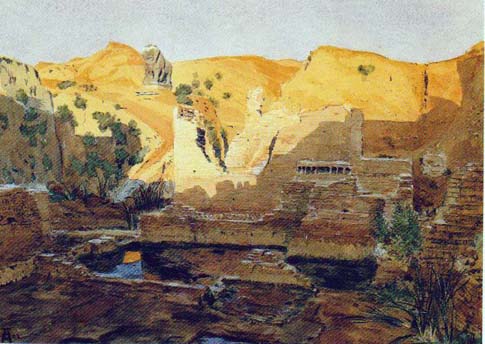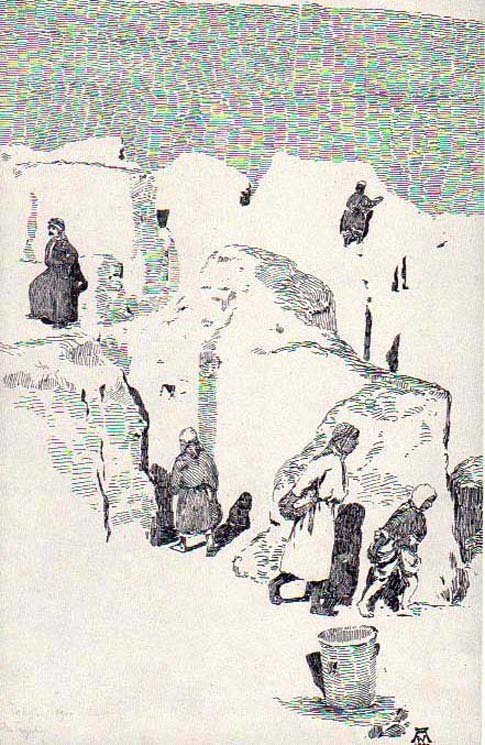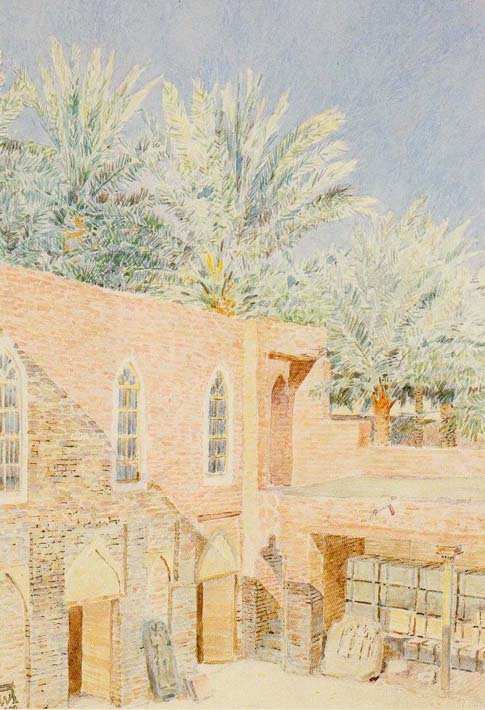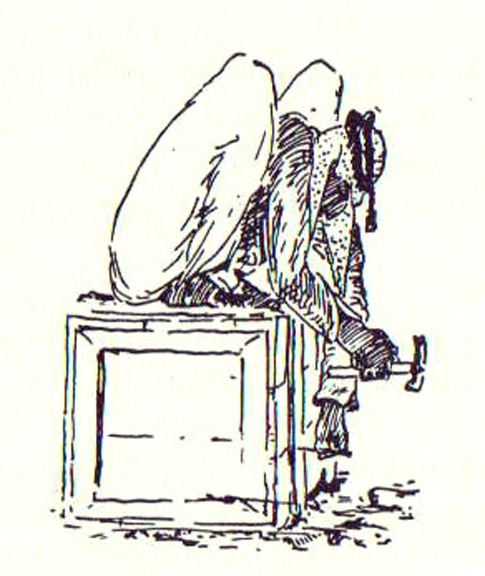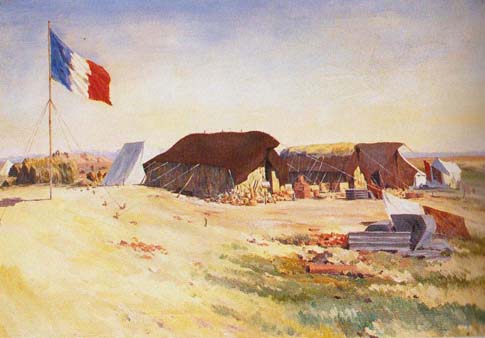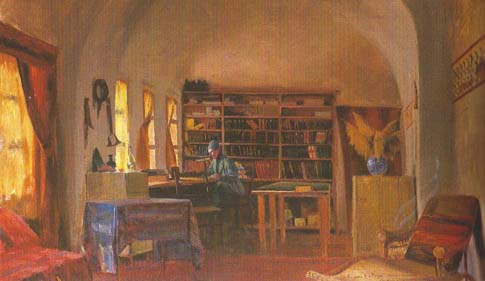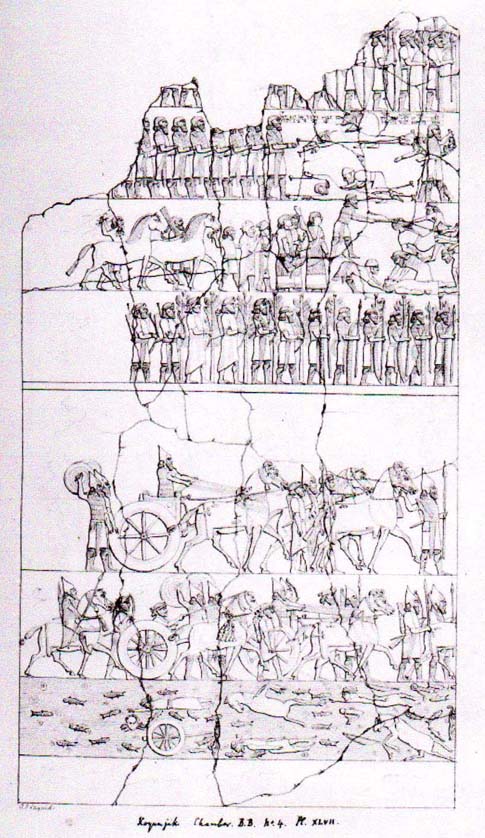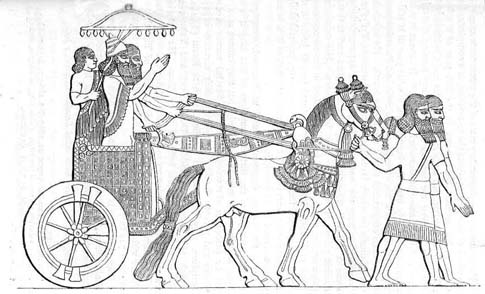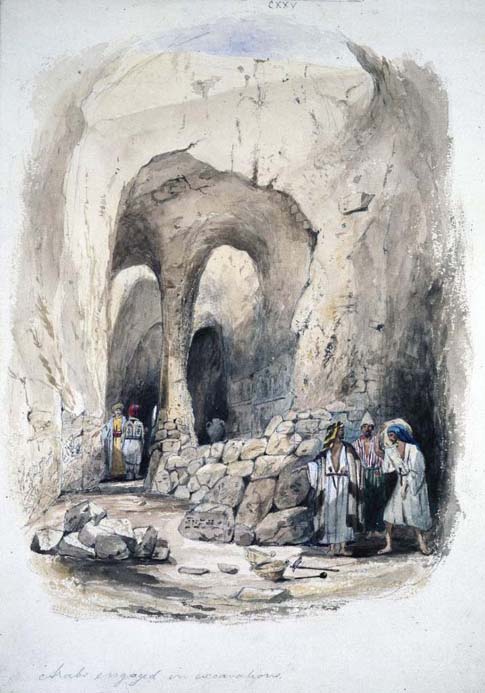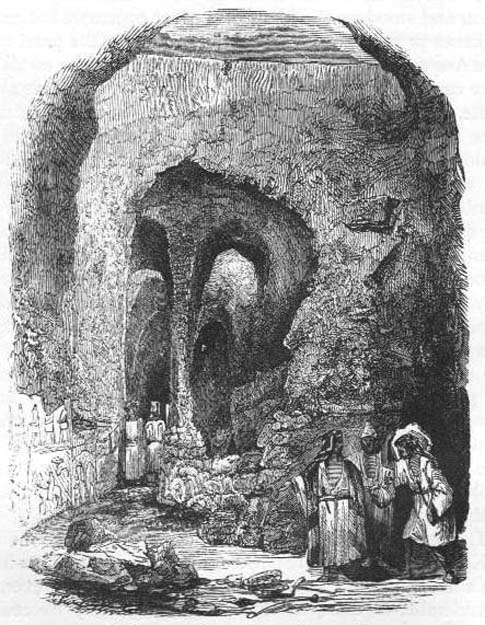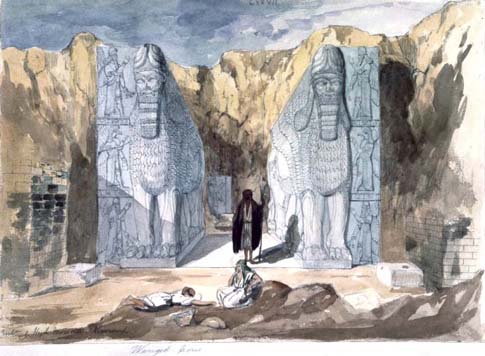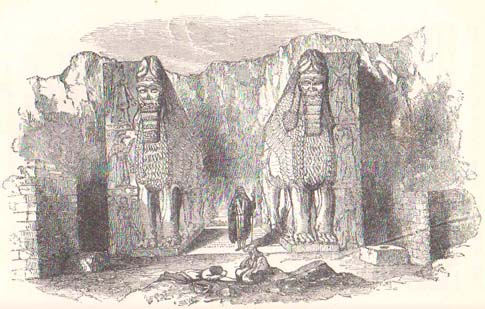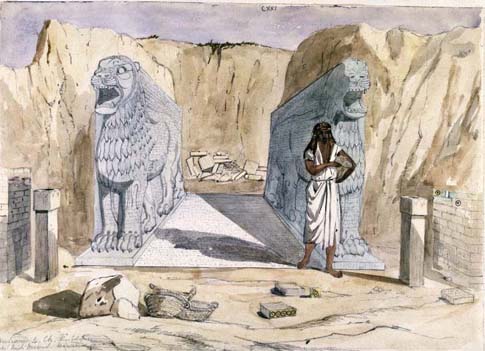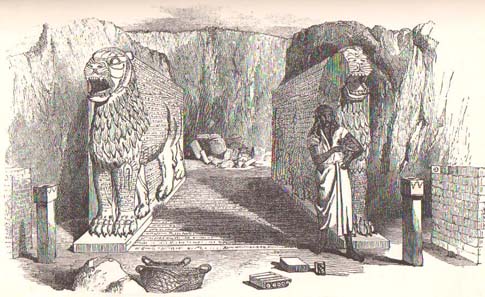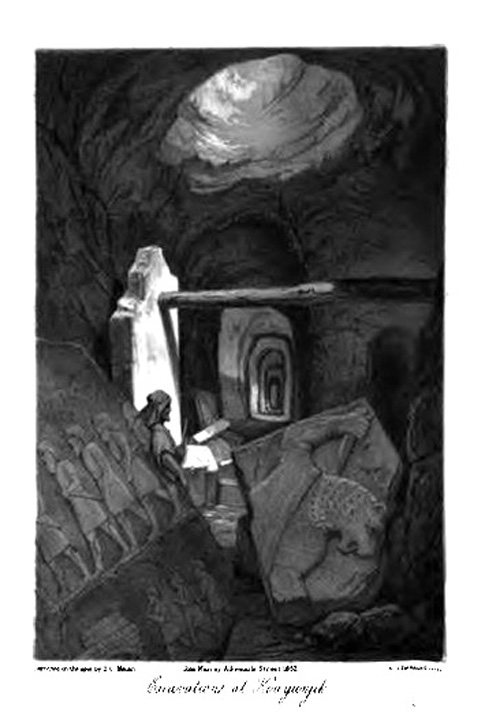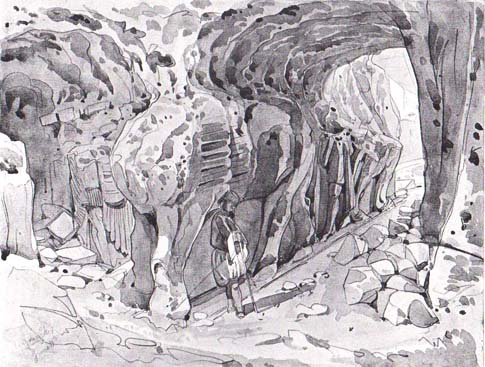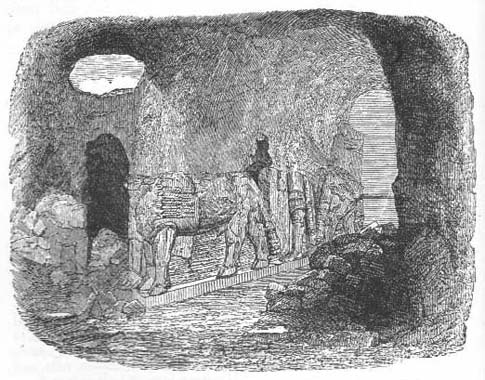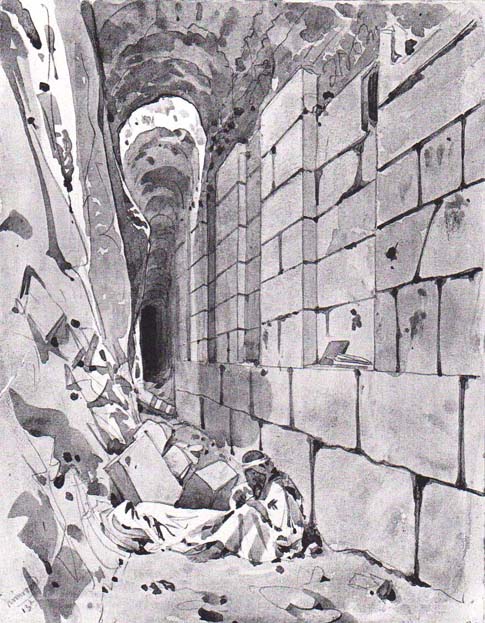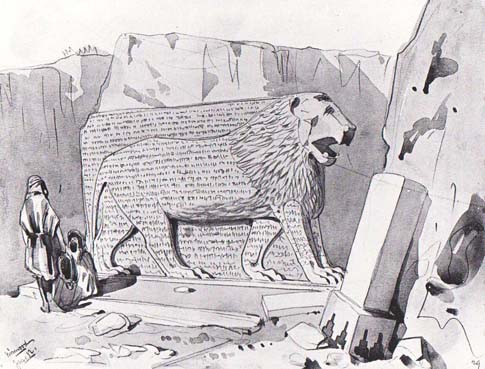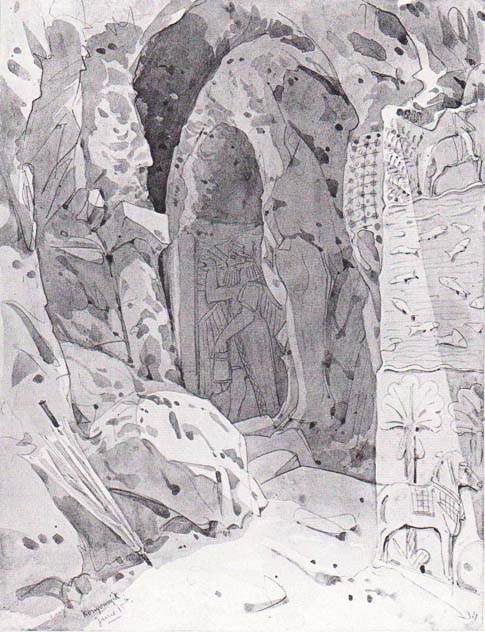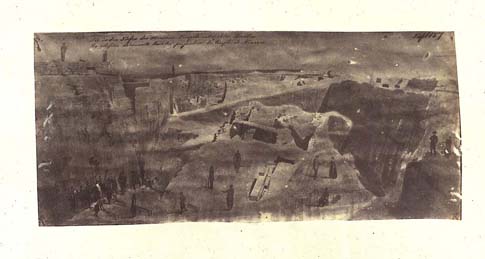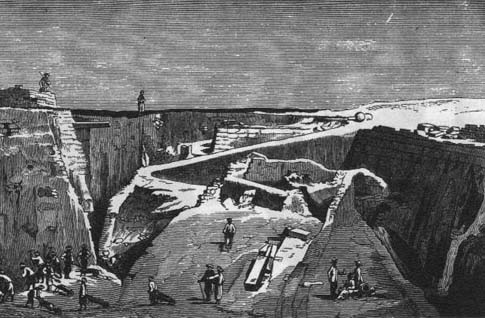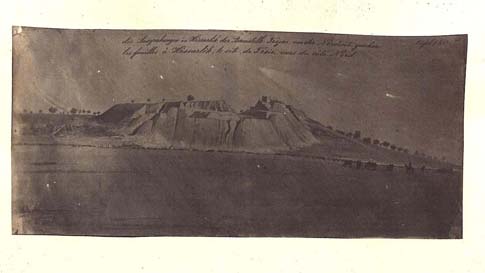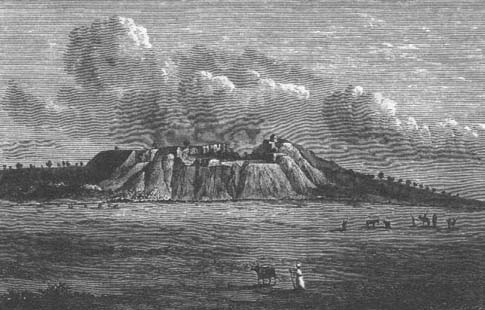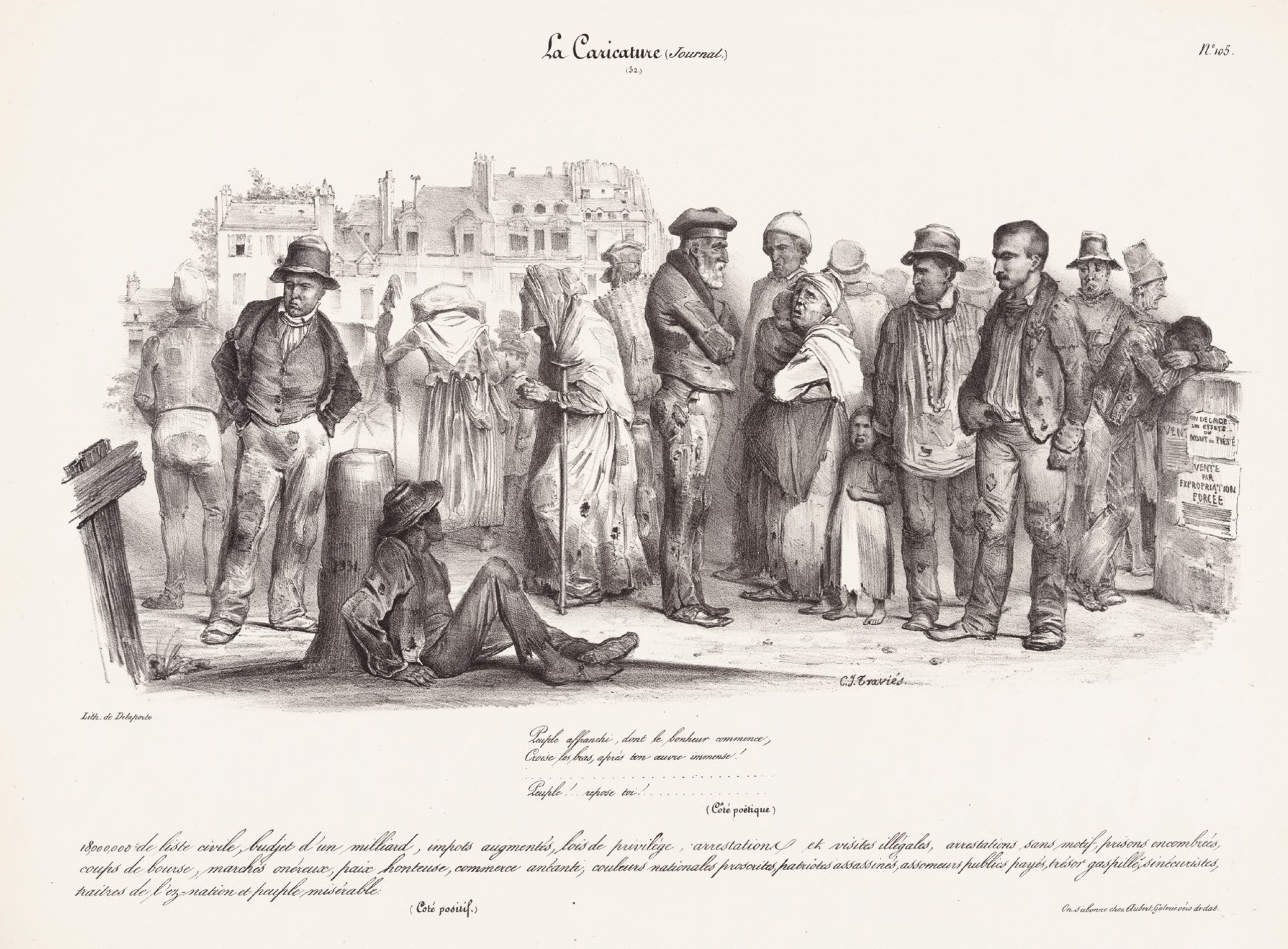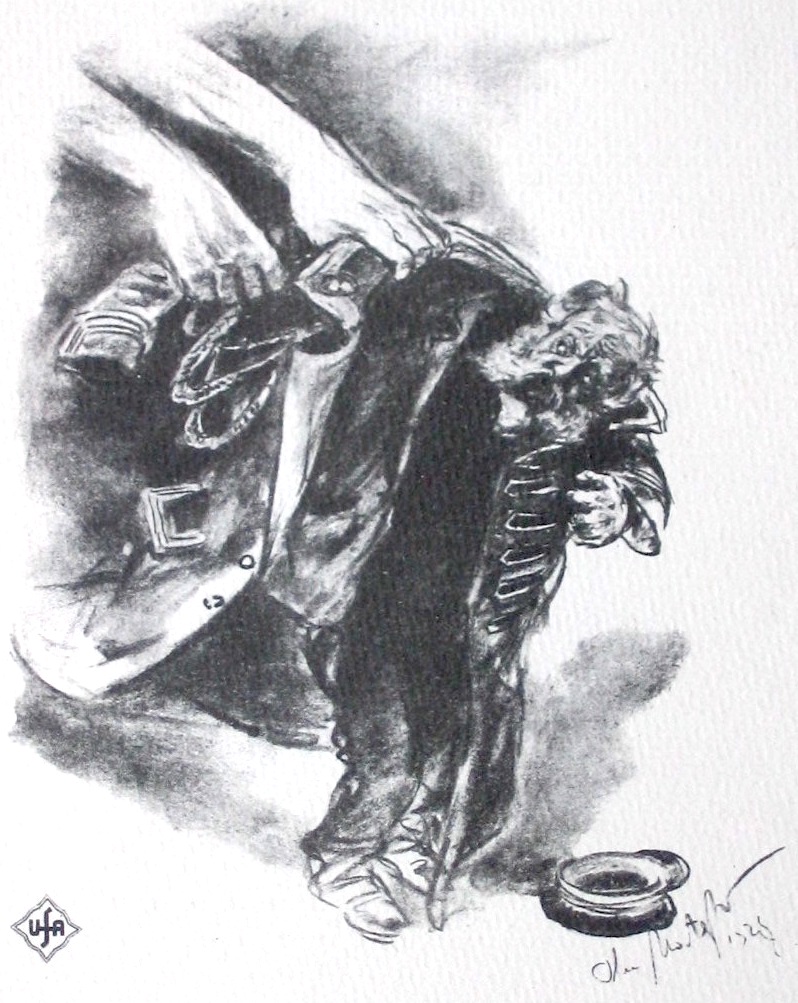Theo de Feyter]
[April 13, 2011
“I took with me a painter” – Archaeologists, artists, draughtsmen and photographers in excavation.
After a conversation on archaeology and drawing, which took place in the MePri in 2006, this rather historical contribution is a second inquiry in the relationship between art, visual documentation and archaeology.
I. Drawing an excavation
In a series of drawings of the archaeological work at the ancient hill of Munbaqa in Syria I tried to catch the situations and atmosphere which are characteristic for this kind of activity. The dark figures of the labourers in the excavation against the bright, hot sand. The boys and men in their jalabya’s, the long traditional dresses, their heads wrapped up in their scarfs to protect themselves against the dusty winds. In the drawings the division of labour is visible, according to which the excavation is organized. The labourers form small groups. One worker handles a big pickax with which he loosens the earth, another one shovels the earth in a wheelbarrow which is wheeled by a third to the earth dump. This dump is situated either at the edge of the excavation or, when the ancient site is very extensive, within the excavation on a spot where there will be no excavation in the foreseeable future. While one man does his job, the other members of his team sit down around a big thermo jug in which the drinking water is kept cool or rest in the shadow of a wheelbarrow. The fourth member of the labourgroup is the most experienced and specialised. He will have worked with the excavators for many years. His tools are a small pick and trowel. He will work out details such as pottery objects, skeletons, architecture and floors together with the site supervisor who is a member of the excavation staff. The main activity of the site supervisor is to administer the excavation pit he has the responsibility for. He or she measures, draws and deliberates about strategies.
Theo de Feyter: Syria – Tell Munbaqa, excavation, watercolour 33 x 48 cm. 2010 (for further examples of this series please go to Pictorial April 2011)
In search for earlier parallels to my own drawings I found out that documenting excavation activities in drawings by an artist is rather rare. There are early examples from the middle of the 19th century (a few will be discussed below) when archaologists made use of artists as draughtsmen. These artists made line-drawings of finds and architecture as well as sketches and watercolours of scenes of the excavation and of people and landscapes. They were travelling artist and technical draughtsman in one. This type of artist/draughtsman has disappeared as member of the excavation team.
This does not mean that drawing is not important in archaeology. In an excavation one of the specialists is always a draughtsman. His task is to draw architecture, objects or pottery sherds in a prescribed, technical way. All the items are photographed as well. Above this the site supervisor draws plans and profiles and makes sometimes informal sketches as a mnemonic device. But a systematic documentation of working circumstances is not a priority in an excavation where every member of the archaeological team, including draughtsman and photographer, is focused on his own special field. It needs a generalist to make cross-overs between the different fields and to notice the pictorial characteristics of the working process; someone who, above that, has the opportunity and time to occupy himself with drawing and/or photographing.
II. The archaeologist as an artist.
Other parallels to my own drawings were not by artists but by archaeologists. The Frenchman Jacques de Morgan (1857 – 1924) was an archaeologist, geologist and civil engineer in the Caucasus, South-East Asia and Persia. Of his many activities his work in the excavation of Susa in Iran is most known. The German Walter Andrae (1875 – 1956) was architect-assistant at the ancient site of Babylon and later director of the excavation of Assur, both in Iraq. One of his more well known projects is the reassembling of the fragments and restauration of the so called Ishtar gate of Babylon, now in the Berlin Pergamon Museum. Both men were accomplished draughtsmen and painters with a near ambition to be artists. Of Andrae it is known that in one stage of his life he seriously considered to abandon architecture and become a painter (1).
Walter Andrae
The drawings of Walter Andrae, totalling several hundreds, can be read like a diary. Halting places, transportation, companions, labourers, and views from his study occur besides many other everyday life motifs. What is striking is that the romantic bias towards antiquated scenes or the folkloristic is totally absent. In Alexandria and Suez he paints the modern steamers in the harbour. In Iraq the cleaning of an irrigation canal or a pontoon bridge over the Euphrates river.
The main reason for the absence of a preconceived, picturesque idiom might be that all Andrae’s artwork is done after nature. True, besides the daily life motifs, there is also the inevitable scenery of palmtrees, ruins, camels and deserts, but in many parts of the Near East that was just how the landscape looked at the end of the 19th century. What all drawings have in common, however, is that they have the flavour of direct observation. This is what makes them recognizable even for us today.
Andrae drew everything and anything. Besides steamers, bridges and canals, also the modern light house in the harbour of Port Said, the flat-bottomed boats on the Euphrates, the garbage heaps on the edge of the village and the enormous spoil heap of the excavation of Babylon. Sometimes the subject matter is more immaterial like the delicate hues in the morning sky or the dazzling reflection of light on the river. Of special interest in the context of this article are the drawings of the excavations of Babylon and Assur: workmen carrying baskets with earth, the watchman’s hut, a workman with a small waggon for transporting dirt, a huge spoil heap, the courtyard of the expedition house with the finds stacked under a roof, and Andrae’s own working chamber (figs. 1 – 6). Very often they are images of ephemeral moments, preserved by someone who wants to testify, so to speak, of this very moment. This makes them essentially different from the average romantic-orientalistic painting which distances itself from the Orient by giving an exotic and alien image.
Fig. 1 Walter Andrae, Spoil heap of the excavation (Babylon) Watercolour 1900
Fig. 2 Walter Andrae, Excavation workman (Babylon) pencil, pen and ink 1900
Fig. 3 Walter Andrae, Excavation in the northern palace and the ‘Lion of Babylon’ Watercolour 1902
Fig. 4 Walter Andrae, Workmen on the site (Babylon) Pen and ink 1900
Fig. 5 Walter Andrae, Expedition house, courtyard with finds (Babylon) Watercolour 1900
Fig. 6 Walter Andrae, Carpenter nailing up a transport chest (Babylon) Pen and ink 1926
Jacques de Morgan
The drawings and paintings of De Morgan have this same flavour of direct observation. They are mainly landscapes and his own surroundings at the several sites that he excavated in Egypt, Malacca and Persia. He invited the architect and artist Emile André (1871 – 1933) to work with him in Susa. André made a long trip to Northern Africa, Egypt, he Near East and Persia from 1894 to 1900. He joined De Morgan in Susa in december 1898 (2). In 1901 he settled in Nancy to become one of the instigators of the Art Nouveau movement in France. He left many sketchbooks, drawings, watercolours and photographs of his travels. The memoirs of Jacques de Morgan, recently published by Andrée Jaunay (1997), are illustrated with drawings and oil paintings by De Morgan himself and with drawings, most probably made after photographs by De Morgan or André (figs. 7 – 12). Workmen in the excavation using small waggons to transport dirt, labourers’ payday with the workmen sitting in a huge circle waiting for their wages to be paid, the contruction of the expedition house and the encampment of the French team in Susa; they are mainly the same motifs from daily life at an excavation as Andrae is picturing.
Nothing much seems to have changed since the end of the 19th century when one compares some of these drawings with my own’s. On payday the labourers still wait quietly, standing around, for their wages to be paid in bare money and they use the same shovels, pickaxes and wheelbarrows. Investigation methods might have modernized – with magnetometric research one can look under the surface of the ancient site and with aerial photography one can see extensive structures in the landscape which are not noticed on the ground – but the actual digging is still handiwork.
Fig. 7 French camp in Susa, Iran Oil painting by De Morgan 1897
Fig. 8 Jacques de Morgan in his working room in the expedition house in Susa (Iran) Oil painting by De Morgan
Fig. 9 Excavation on the citadel of Susa (Iran) In the foreground the stele of Naram-sin. Drawing after photograph by De Morgan or André? 1898
Fig. 10 Excavation on the citadel of Susa (Iran) Drawing after photograph by De Morgan or André?
Fig. 11 Excavation on the citadel of Susa (Iran). The trenches in december 1898. Drawing after photograph by De Morgan or André?
Fig. 12 Workmen waiting for their daily wage, Susa (Iran). Drawing after photograph by De Morgan or André?
Orientalism
It is striking that both men, Andrae und De Morgan, working at the end of the 19th and beginning of the 20th century don’t seem to have undergone any influence of Orientalism, still a very popular style in European history painting at the time. Instead one can see in the paintings of Andrae the influence of modernist styles, first Impressionism and later Fauvism. The paintings of De Morgan are more reserved and descriptive in character. In subject matter both are dedicated to their direct surroundings, noticing the daily aspects of life without stressing the exotic side of it.
This is very rare indeed where most professional artists would document exotic types and objects in drawing, arrange a ‘daily life scene’ in a composition and do the painting in the studio. A good example for this manner is ‘Old Damascus, Jewish quarter’ by Sir Frederick Leighton (1830 – 1896) (fig. 13). This work pictures two ladies and a girl in the courtyard of a tradional family mansion trying to reach the high hanging lemons in a tree (the work is also known as ‘Picking lemons’ ). During a visit to Syria Leighton bought the dresses and objects like the wooden mules that can be seen in the painting and made sketches of the decoration of the courtyard. He designed and finished the painting, however, in his London studio. The result is a stage set, more than a painting (3).
Artists with a less romantic attitude, working sometimes for anthropological museums in a descriptive style nevertheless focused on the folkloristic. Even modernists like Matisse and Van Dongen continue the tradition of Orientalism with depictions of odalisques and Moorish dancing girls.
Fig. 13 Lord Frederick Leighton. Old Damascus: the Jewish quarter. Oil on canvas, 1873-74, private collection.
III. Archaeological publications: artists and photographers.
Layard and Nineveh
There were many more ‘archaeological’ drawings in the 19th century in the form of preparatory drawings for the engravings published in books about archaeology. These preparatory drawings were made by artists or architects as members of the excavation team.Two examples of publications by early explorers will give an insight in the way the excavations were documented.
Austen Henry Layard (1817 – 1894) was among the first excavators (from 1845 till 1851) of Nimrud and Nineve, two capitals of the Assyrian Empire, in the north of Iraq. Layard himself was a skilled draughtsman and made many of the line-drawings of the reliefs and other sculptures found in the excavation. From 1849 on the Trustees of the British Museum sent several artists to assist Layard. Of these artists one is of special interest. Frederick Charles Cooper, who worked with Layard in 1849 and 1850, not only made copies of the reliefslabs and other finds (called ‘drawings’by him), but also many pencil drawings and watercolours of people, landscapes and excavation scenes (called ‘sketches’ by him) (4).
Layard’s scientific publications (Monuments of Nineveh, London 1948 and A second series of Monuments of Nineveh, London 1853) are illustrated with lithographies, engravings (or a combination of those two) ‘made from drawings on the spot’ as he emphatically states on the title pages. With the ‘drawings on the spot’ are meant the line-drawings of the reliefs and other sculpture (figs. 14 – 16). The popular editions, starting in 1853 and continuing till the end of the century are travel accounts as well as accounts of the archaeological work at the sites of Nimrud and Nineveh. Besides the rather dry representations of the actual finds the books are illustrated with lithographs and wood engravings based on Cooper’s sketches and watercolours. They show lively scenes of the work in the excavation, of the digging and complicated transport of the huge sculptures (figs. 17 – 22).
The organisation of an excavation in the middle of the 19th century appears to be much more primitive than fifty years later in the time of Andrae and De Morgan. Digging in Layard’s time was at random, i.e. everywhere where one expected monumental sculpture and architecture. The scenes depicted by Cooper are almost hilarious for the modern archaeologist. Layard was tunnelling his way through the ancient hill using mining techniques to strut the ceilings and walls. The idea of stratigraphic research had clearly not yet develeoped.
Fig. 14 S. C. Malan. Mr. Layard at Kooyoonjik. Pencil, 1850
Fig. 15 A. H. Layard. Relief from room XXXIII (BB) of South West palace at Nineveh.
Pencil on whitish paper, ca. 1850. (British Museum, London)
Fig. 16 Bas-relief, representing Pul, or Tiglath Pileser. (Nimrud) Wood engraving
Fig. 17 F.C. Cooper. Arabs engaged in excavation. (Nineveh) Watercolour over pencil, 1849 – 50 (British Museum, London)
Fig. 18 Underground excavation at Kouyunjik. (Nineveh) Wood engraving
Fig. 19 F.C. Cooper. Winged lions. (Nimrud) Watercolour over pencil, 1849 –50 (British Museum, London)
Fig. 20 Entrance to small temple. (Nimrud) Wood engraving
Fig. 21 F.C. Cooper. Entrance to temple. (Nimrud) Watercolour over pencil, 1849 – 50 (British Museum, London)
Fig. 22 Entrance to small temple dedicated to Beltis. (Nimrud) Wood engaving
Cooper’s sketches are not the only source of illustrations. At the beginning of chapter XVII of Discoveries in the ruins of Nineveh and Babylon with travels in Armenia, Kurdistan and the desert (London 1853) Layard mentions several visitors, among others ‘the Rev. Mr. Malan to whom I am indebted for many beautiful sketches, and of whose kindness in affording me these valuable illustrations I again seize the opportunity of making a grateful acknowledgement.’ (5). This artistic clergyman was Salomon Caesar Malan (1812 – 1894) who visited Mosul with his wife in 1850 from June 10 to 20. Everyday he went over to nearby Nineveh to draw the work on the ancient hill. Underneath the four lithographs, made after these sketches and published in Discoveries etc., it is proudly stated: ‘sketched on the spot by S. C. Malan’. (fig. 23) Malan’s watercolours are not easily recognizable in Layard’s publications. They were apparently reworked to fit in with the style of the rest of the illustrations. (figs. 24 – 28) (See also Gadd (1938) on the visit of Malan to Mosul and Nineveh)
Fig. 23 M. Chevalier. Excavations at Kouyunjik. (Nineveh) Lithography after S. C. Malan
Fig. 24 S. C. Malan. At Kooyoonjik, Nineveh. Pencil, pen and ink, watercolour 1850
Fig. 25 Bull with historical inscriptions of Sennacherib (Kouyunjik) (Nineveh) Wood engraving
Fig. 26 S. C. Malan. Foundations of the pyramid, Nimroud. Pencil, pen and ink, watercolour 1850
Fig. 27 S. C. Malan. Lion, Nimroud. Pencil, pen and ink, watercolour 1850
Fig. 28 S. C. Malan. Excavtions at Kooyoonjik, Nineveh. Pencil, pen and ink, watercolour 1850
In 1850 Cooper fell ill and was succeeded by the artist T. S. Bell who only worked for Layard for six weeks until he drowned in a side river of the Tigris during a trip to Nimrud. In this short period Bell made drawings of the bas-reliefs. Possibly he had other plans as well, because in a list of Bell’s materials and tools a ‘talbotype’ is mentioned (6). A talbotype is a photographic device, most probably a camera and materials for making paper negatives with which so-called calotypes could be printed, an invention by Henry Fox Talbot, patented in 1841 (7).
The paper negative technique is especially well suited for working in difficult circumstances like travel and exploring, since the paper can be prepared in advance and developed later in the dark room. Nevertheless no calotypes of the ruins of Nineveh are known to us from the period Bell worked with Layard. From the fifties of the 19th century only a scanty number of four photographs of Nineveh and Nimrud are known, made by Bell’s successors. (8) Although other archaeological missions were more succesfull in using photos (on the nearby site of Khorsabad for instance Victor Place from 1852 on produced many calotypes of details of his excavation) photography was clearly not yet a widepread possibility to document and register excavations in the field.
Schliemann and Troy
This had changed a few decades later. Heinrich Schliemann (1822 – 1890) started excavating the hill of Hisarlik, the ancient Troy, in Turkey in 1870. After ending the first period of work in 1873, he published the results in Trojanische Alterthümer. Bericht über die Ausgrabungen in Troja (Leipzig 1874). The plates appeared in a seperate volume under the title Atlas Trojanischer Alterthümer. Photographische Abbildungen zu dem Berichte über die Ausgrabungen in Troja (Leipzig 1874). (Photographic images to the reports of the excavations in Troy.) The Atlas consisted of printed captions with a portfolio of photographs. The textvolume appeared in an edition of 1000 copies, the volume with the plates in an edition of 400 – 500 copies only. The original drawings and objects had been sent to Athens and photographed and printed by Panagos Th. Zaphyropolos who owned a photo studio in Athens (9). The landscape and excavation photographs were made by a man called Siebrecht: ‘Auch nahm ich von den Dardanellen den Photographen Siebrecht mit um Photographien von meinem Ausgrabungen, von zwei der vier an der Nordseite von Ilium befindlichen Quellen, von Iliums grossem Thurm und Trojas Ebene, und dem Hellespont, von diesem Monument aus gesehen, aufzunehmen.’ (‘From the Dardanelles I took the photographer Siebrecht with me to take pictures of my excavation, of two of four fountains to the north of Iion, of Ilion’s great tower and the plain of Troy, and the Hellespont seen from this monument) (10).
The invention of the paper negative and later the glass negative (in 1841 and 1851 respectively) made it possible to make photographs outside and reproduce them in prints. Although less brillant and detailed than prints from a glass negative the paper negative has the advantage that retouching, i.e. drawing and painting on the negative, is much easier. The photographic illustrations of the Atlas Trojanischer Alterthümerare contact prints on albimine paper, cut out and glued on seperate sheets of paper. several of the prints one can see the traces of retouching: details which did not appear to be sufficient clear have been redrawn on the negative with pen and ink (figs. 29 – 32). The Atlas an early example of the use of photography for archaeological publications, faultily as it may be. The photographs of the drawings of pottery and decorations are fairly well reproduced, but the pictures of landscapes and the excavation itself are rather dark and sometimes blurred and it is not always clear what information they were expected to give, other than the message that Schliemann was a modern archaeologist and conducted a modern excavation. The speed with which this first series of excavations was published – only one year after conclusion – may also give an indication for Schliemann’s choice for photography as a means of reproduction. No engraver or lithographer had to be called in to rework drawings, watercolours or photographs. Editing the book was much easier as well: the photographs were glued in and handwritten on with the relevant information and collected in a portfolio. The quality, however, of the photographs was apparently considered bad, since the English editions of Trojanische Alterthümer, which appeared in the following years, contain wood engravings made after the photographs (Schliemann 1875 and 1876). Also the popular edition in German, augmented with an autobiography, was exclusively illustrated with engravings and lithographs based on the photographs (Schliemann 1881) (figs. 33 – 36).
Fig. 29 Siebrecht, Das Skaeische Thor und die Ruinen des Hauses des Priamos, Troy. Photographic print on albumine paper, ca. 1873
Fig. 30 Siebrecht, Ansicht der Ausgrabung in den Tiefen des Minervatempels, Troy. Photographic print on albumine paper, ca. 1873
Fig. 31 Siebrecht Der grosse, durch den ganzen Berg gehenden Einschnitt an der Nordseite, Troy. Photographic print on albumine paper, ca. 1873
Fig. 32 Siebrecht Iliums grosser Thurm, Troy. Photographic print on albumine paper, ca.
1873
Fig. 33 Siebrecht, Haus in den Tiefen des Minervatempels, Troy. Photographic print on
albumine paper, ca. 1873
Fig. 34 Unterhalb des Athene-tempels (sic) entdeckte trojanische Häuser. Wood engraving
Fig. 35 Siebrecht, Die Ausgrabung von der Nordseite, Troy. Photographic print on albumine paper, ca. 1873
Fig. 36 Troja, wie es nach den Ausgrabungen von 1871 – 1873 aussah. Nordseite. Ansicht vom Ufer des alten Skamander. Wood engraving
Drawing and/or photography.
In the decades after its invention the differences between drawings and photographs were noticed and discussed among historians and archaeologists. For some archaeologists photography had the advantage of being more accurate than the work of a drawing artist. In spite of the initial difficulties to use photography in the field, almost immediately after its invention photography was used to register excavated architecture. In 1851 Victor Place, the French consul in Baghdad archaeologist, stated in a letter to the Department of the Interior: ‘From now on it is not necessary anymore to send a draughtsman, because in this case [of photography] one can produce images more exact than the artistic ones.’ (11) This, however, is not what actually happened. In reality photographer and draughtsman worked next to each other, each developing its own specialities. Photographs in that view were exact representations while drawings had a more analytical approach. In the beginning photographs were more or less spontaneous snapshots showing all kinds of ‘polluting’details, like tools, scaffolding, etc. In the following decades they developed towards ‘photographic demonstrations’ in which all unnecessary objects, tools and people were removed and the excavated architecture cleaned. In 1857 the landscape photographer Ëduard Loydreau evaluated these developments in a lecture for the Société d’histoire et d’archéologiede Chalon-sur-Saônein France. ‘Photography applied to the study of archaeology should be handled more with the intelligence of this science. Even if photographs will succeed in making a very beautiful portrait, giving it real life, or will reproduce a landscape in which the air circulates, the plans are duly differentiated and the play of light is pleasant, it would still make a mediocre proof of archaeology. In picturing animated nature, landscapes, statues, one has to know how to concentrate the light on certain spots in order to obtain vigorous contrasts, one has to sacrifice details to the overall effect. In picturing an archeaological object, however, one has to sacrifice the overall effect to the detail.’ (12) Likewise drawings developed towards demonstrations of scientific analysis in which the specialised draughtsman drew more what he knew, than what he saw. And this is still the custom in archaeology up till this day.
No artists work in an excavation anymore with the exception of an archaeologist with a talent for drawing and painting or a travelling artist with an eye for ‘effect’.
Notes
1. Andrae and Boehmer 1992: 14
2. Jaunay 1997: 469
3. The house has been identified as the former residence of the Jewish Farhi family. In the 19th century Farhi was the treasurer of the Ottoman governor of Damascus. The mansion still exists and Leighton’s painting became of current interest when the house was being restored in recent years.
4. Turner 2003: 198
5. Layard 1853: 363 –364
6. Turner 2003: 200
7. Interestingly enough Talbot also occupied himself with the cuneiform inscriptions of Nineneh. In the introduction of the popular edition Layard mentions him as one of the decipherers (Layard 1897: xlvi)
8. Turner 2003: 200
9. Schliemann TrojanischeAlterthümer 1874: XLVIII, 185 (‘Ich habe auch einen Maler mitgenommen, um die gefundenen Gegentände immer sogleich mit chinesischer Tinte abzeichnen und die Zeichnungen in Athen durch Photographie vervielfältigen zu lassen.’ (I also took with me a painter. He instantly drew the found objects with Indian ink. In Athens the drawings were multipied by photography.’))
10. Schliemann Trojanische Alterthümer 1874: 179 (letter from Athens, September 23, 1872)
11. cited in Feyler 1987: 1029 – 30
12. cited in Feyler 1987: 1034 – 35
Literature
Andrae, E.W, and Boehmer, R.M.: Bilder eines Ausgräbers, Walter Andrae im Orient 1898-1919. Berlin 1992
Benesch, Kurt (ed.): Heinrich Schliemann, die Goldschätze der Antik.Wien 1978 (abridged edition of Schliemann 1881)
Feyler, Gabrielle: Contribution à l’histoire des origines de la photographie archéoplogique: 1839 – 1880.In: MEFRA (Mélanges de l’école française de Rome, Antiquité): 99,2 (1987): 1019 – 1047
Gadd, C. J.: A visiting artist at Nineveh in 1850. In: Iraq V (1938): 118 – 122
Jaunay, Andrëe (ed): Mëmoires de Jacques de Morgan, souvenirs d’un archéologue. Paris, Montréal 1997
Layard, Austen Henry: Discoveries in the ruins of Nineveh and Babylon with travels in Armenia, Kurdistan and the desert London 1853
Layard, Austen Henry: Nineveh and Babylon. A narrative of a second expedition to Assyria. London 1897
Schliemann, Heinrich: Trojanische Alterthümer. Bericht über die Ausgrabungen in Troja. Leipzig 1874
Schliemann, Heinrich: Atlas Trojanischer Alterthümer. Photographische Abbildungen zu dem Berichte über die Ausgrabungen in Troja. Leipzig 1874
Schliemann, Heinrich: Troy and its remains: a narrative of researches and discoveries made on the site of Ilium and in the Trojan plain.London 1875, New York 1876
Schliemann, Heinrich: Ilios, Stadt und Land der Trojaner. Forschungen und Entdeckungen in der Troas und besonders auf der Baustelle von Troja mit einer Selbstbiographie des Verfassers. 1881
Trümpler, Charlotte (ed.): Das grosse Spiel. Archölogie und Politik. Köln 2010
Turner, Geoffrey: Sennacherib’s palace at Nineveh: the primary sources for Layard’s second campaign. In: Iraq LXV (2003): 175 – 220
Figures
Figures 1 – 6 from: Andrae and Boehmer 1992, figs. 75, 78, 87, 207, 49 and page 145
Figures 7 and 8 from: Trümpler 2010, pages 268 and 272
Figures 9 – 12 from: Jaunay 1997, pages 461, 470 and 451
Figures 14,24, 26 – 28 from: Gadd 1938, plates XIX, XVIII, XIV, XIII and XVII
Figures 16, 18, 20, 22 and 25 from: Layard 1897, pages 359, 6, 176, 181 and 46
Figure 23 from Layard 1853, page 104
Figures 29 – 33 and 35 from Schliemann, Atlas 1874: plates 169, 170, 186, 110, 157 and 180
Figures 34 and 36 from Benesch 1978: pages 182 and 203
